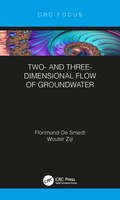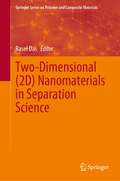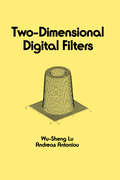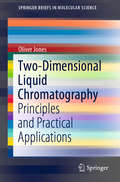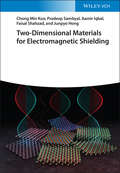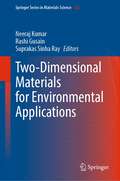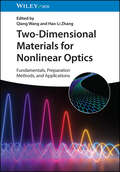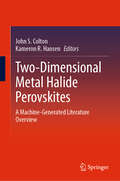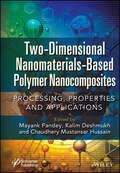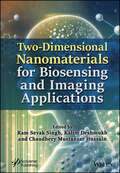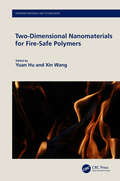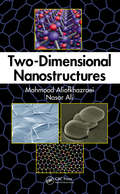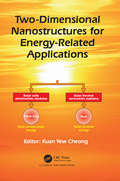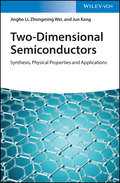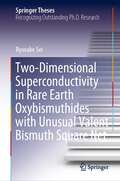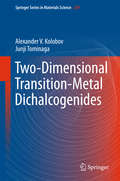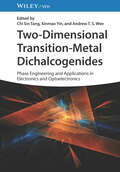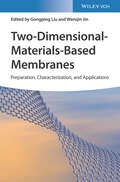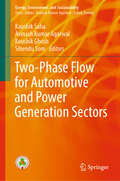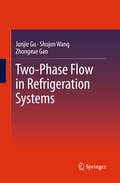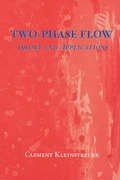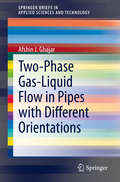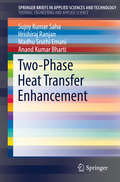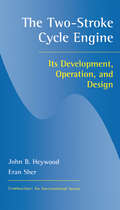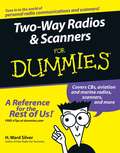- Table View
- List View
Two- and Three-Dimensional Flow of Groundwater
by Wouter Zijl Florimond De SmedtThis monograph is a practical guide to groundwater flow theory intended to serve students and practitioners by bridging the gap between basic hydrogeology and groundwater modeling. It synthesizes the mathematics of groundwater flow and provides information in an easily-accessible format for practicing groundwater professionals, consultants, and students that intend to become skillful and competent groundwater flow modelers.
Two-Dimensional (Springer Series on Polymer and Composite Materials)
by Rasel DasThis book covers newly emerging two-dimensional nanomaterials which have been recently used for the purpose of water purification. It focuses on the synthesis methods of 2D materials and answers how scientists/engineers/nanotechnologist/environmentalists could use these materials for fabricating new separation membranes and most probably making commercially feasible technology. The chapters are written by a collection of international experts ensuring a broad view of each topic. The book will be of interest to experienced researchers as well as young scientists looking for an introduction into 2D materials-based cross-disciplinary research.
Two-Dimensional Digital Filters (Electrical And Computer Engineering Ser. #80)
by Wu-Sheng Lu Andreas AntoniouPresents basic theories, techniques, and procedures used to analyze, design, and implement two-dimensional filters; and surveys a number of applications in image and seismic data processing that demonstrate their use in real-world signal processing. For graduate students in electrical and computer e
Two-Dimensional Liquid Chromatography: Principles and Practical Applications (SpringerBriefs in Molecular Science)
by Oliver JonesThis book addresses the growing interest in the field of two-dimensional liquid chromatography (2DLC), a powerful approach to increasing resolution, available peak capacity, and selectivity in analytical chromatography. 2DLC is suitable for many applications, including in the pharmaceutical and polymer industries and the omic sciences (metabolomics, lipidomics and proteomics). Thanks to recent advances in technology and software the instrumentation needed to perform 2D-LC is broadly available to the analytical community in both industry and academia. Indeed, the technique can now be considered ready for application in R&D as well as in QA and QC labs, yet it is not widely known about outside academic laboratories and is rarely taught at the undergraduate level. This book outlines the main principles and features of 2D-LC (including comprehensive and heart-cutting modes, method development and real world applications) to enable modern analysts to start using this fascinating technique. The book offers an ideal starting point for those wishing to get into 2D-LC and will also be of interest to more experienced scientists in the field.
Two-Dimensional Materials for Electromagnetic Shielding
by Pradeep Sambyal Chong Min Koo Aamir Iqbal Faisal Shahzad Junpyo HongDiscover a cutting-edge reference on 2D EMI shielding materials for both industrial and academic audiences Two-Dimensional Materials for Electromagnetic Shielding delivers a thorough and comprehensive examination of all aspects of electromagnetic interference (EMI) shielding and microwave absorption, including fundamentals and applications, as well as emerging 2D materials in the field, like graphene, black phosphorus, and MXene. The book covers basic knowledge on shielding mechanisms and the demanding physical, chemical, and mechanical properties of the 2D materials against betrayed electromagnetic waves. The benefits of novel 2D materials over existing materials is thoroughly explained and the reader is provided with insight into future developments in shielding materials in highly integrated electrical and electronic equipment. The book offers explanations and in-depth descriptions of graphene and MXenes materials, as well as likely future challenges that will confront practitioners in the field. Ideal for scientists, researchers, and engineers who design novel EMI shielding materials, the book also provides: A thorough introduction to electromagnetic field sources and their impact on human beings, including natural and artificial sources and their effects on human health An exploration of EMI shielding mechanism and conversion techniques, including microwave absorption mechanisms and scattering parameter conversion methods Discussions of measurements and standards in EMI shielding, including effectiveness measurements An examination of graphene and its derivatives for EMI shielding, as well as its effectiveness as a microwave absorber Perfect for materials scientists, electrochemists, inorganic chemists, physical chemists, and radiation chemists, Two-Dimensional Materials for Electromagnetic Shielding will also earn a place in the libraries of applied physicists and engineering scientists in industry seeking a one-stop reference on cutting-edge 2D electromagnetic interference shielding materials.
Two-Dimensional Materials for Environmental Applications (Springer Series in Materials Science #332)
by Neeraj Kumar Suprakas Sinha Ray Rashi GusainThis book focuses on recent developments in the field of two-dimensional nanomaterials for environmental applications. Due to their high surface area and tunable surface chemistry, two-dimensional nanomaterials are currently garnering great interest for environmental remediation applications. This book compiles contributed chapters from active international researchers dealing with the development of state-of-the-art two-dimensional nanomaterials in environmental applications such as water and wastewater treatment, adsorption, photocatalysis, membrane separation, desalination, deionization, environmental pollutants sensing/detection, carbon-dioxide capture and catalytic conversion, microbial treatment, and electrochemical remediation. Each chapter provides an essential and comprehensive overview of the recent advances in material development and application, giving special attention to preparation methods, tunning of physiochemical properties, surface and interface chemistry, structural porosity, assemblies integration for fabrication of devices, and their relationship with overall efficiency. It offers a valuable reference guide for environmental and materials scientists, engineers, and policymakers working towards environmental sustainability.
Two-Dimensional Materials for Nonlinear Optics: Fundamentals, Preparation Methods, and Applications
by Qiang Wang; Hao-Li ZhangTwo-Dimensional Materials for Nonlinear Optics Comprehensive resource covering concepts, perspectives, and skills required to understand the preparation, nonlinear optics, and applications of two-dimensional (2D) materials Bringing together many interdisciplinary experts in the field of 2D materials with their applications in nonlinear optics, Two-Dimensional Materials for Nonlinear Optics covers preparation methods for various novel 2D materials, such as transition metal dichalcogenides (TMDs) and single elemental 2D materials, excited-state dynamics of 2D materials behind their outstanding performance in photonic devices, instrumentation for exploring the photoinduced excited-state dynamics of the 2D materials spanning a wide time scale from ultrafast to slow, and future trends of 2D materials on a series of issues like fabrications, dynamic investigations, and photonic/optoelectronic applications. Powerful nonlinear optical characterization techniques, such as Z-scan measurement, femtosecond transient absorption spectroscopy, and microscopy, are also introduced. Edited by two highly qualified academics with extensive experience in the field, Two-Dimensional Materials for Nonlinear Optics covers sample topics such as: Foundational knowledge on nonlinear optical properties, and fundamentals and preparation methods of 2D materials with nonlinear optical properties Modulation and enhancement of optical nonlinearity in 2D materials, and nonlinear optical characterization techniques for 2D materials and their applications in a specific field Novel nonlinear optical imaging systems, ultrafast time-resolved spectroscopy for investigating carrier dynamics in emerging 2D materials, and transient terahertz spectroscopy 2D materials for optical limiting, saturable absorber, second and third harmonic generation, nanolasers, and space use With collective insight from researchers in many different interdisciplinary fields, Two-Dimensional Materials for Nonlinear Optics is an essential resource for materials scientists, solid state chemists and physicists, photochemists, and professionals in the semiconductor industry who are interested in understanding the state of the art in the field.
Two-Dimensional Metal Halide Perovskites: A Machine-Generated Literature Overview
by John S. Colton Kameron R. HansenThis book presents the result of an innovative challenge, to create a systematic literature overview driven by machine-generated content. Questions and related keywords were prepared for the machine to query, discover, collate and structure by Artificial Intelligence (AI) clustering. The AI-based approach seemed especially suitable to provide an innovative perspective as the topics are indeed both complex, interdisciplinary and multidisciplinary, for example, climate, planetary and evolution sciences. Springer Nature has published much on these topics in its journals over the years, so the challenge was for the machine to identify the most relevant content and present it in a structured way that the reader would find useful. The automatically generated literature summaries in this book are intended as a springboard to further discoverability. They are particularly useful to readers with limited time, looking to learn more about the subject quickly and especially if they are new to the topics. Springer Nature seeks to support anyone who needs a fast and effective start in their content discovery journey, from the undergraduate student exploring interdisciplinary content to Master- or PhD-thesis developing research questions, to the practitioner seeking support materials, this book can serve as an inspiration, to name a few examples. It is important to us as a publisher to make the advances in technology easily accessible to our authors and find new ways of AI-based author services that allow human-machine interaction to generate readable, usable, collated, research content.
Two-Dimensional Nanomaterials Based Polymer Nanocomposites: Processing, Properties and Applications
by Chaudhery Mustansar Hussain Kalim Deshmukh Mayank PandeyTwo-Dimensional Nanomaterials-Based Polymer Nanocomposites This book presents an extensive discussion on fundamental chemistry, classifications, structure, unique properties, and applications of various 2D nanomaterials. The advent of graphene in 2004 has brought tremendous attention to two-dimensional (2D) nanomaterials. Lately, this has prompted researchers to explore new 2D nanomaterials for cutting-edge research in diverse fields. Polymer nanocomposites (PNCs) represent a fascinating group of novel materials that exhibit intriguing properties. The unique combination of polymer and nanomaterial not only overcomes the limitations of polymer matrices, but also changes their structural, morphological, and physicochemical properties thereby broadening their application potential. The book, comprising 22 chapters, provides a unique and detailed study of the process involved in the synthesis of 2D nanomaterials, modification strategies of 2D nanomaterials, and numerous applications of 2D nanomaterials-based polymer nanocomposites. The book also emphasizes the existing challenges in the functionalization and exfoliation of 2D nanomaterials as well as the chemical, structural, electrical, thermal, mechanical, and biological properties of 2D nanomaterials-based polymer nanocomposites. The key features of this book are: Provides fundamental information and a clear understanding of synthesis, processing methods, structure and physicochemical properties of 2D materials-based polymer nanocomposites; Presents a comprehensive review of several recent accomplishments and key scientific and technological challenges in developing 2D materials-based polymer nanocomposites; Explores various processing and fabrication methods and emerging applications of 2D materials-based polymer nanocomposites. Audience Engineers and polymer scientists in the electrical, coatings, and biomedical industries will find this book very useful. Advanced students in materials science and polymer science will find it a fount of information.
Two-Dimensional Nanomaterials for Biosensing and Imaging Applications
by Chaudhery Mustansar Hussain Ram Sevak Singh Kalim DeshmukhThe book is essential for anyone eager to understand the transformative potential of 2D nanomaterials in biotechnology and medical science, offering in-depth insights into their unique properties, synthesis methods, and practical applications in an ever-evolving field. Nanotechnology is pivotal in advancing biotechnology and medical science. Nanomaterials, essential components of this technology, showcase unique and superior physicochemical properties when compared to their bulk equivalents. Since the groundbreaking discovery of graphene in 2004, two-dimensional (2D) nanomaterials have garnered immense attention for their potential in a wide range of applications across multiple industries including biochemistry, biophysics, and engineering. Two-Dimensional Nanomaterials for Biosensing and Imaging Applications examines the current state and new challenges associated with the development of 2D nanomaterials for biosensing and imaging applications. This volume focuses on the synthesis, processing methods, characterization, properties, and applications of 2D nanomaterials, their nanocomposites or heterostructures for biosensors and imaging devices, and the essential criteria in each specified field. Comparative performance evaluations of various biosensor devices and their advantages and disadvantages for the commercialization of 2D materials-based biosensors are comprehensively covered, giving essential insight into the challenges this technology presents. A handpicked selection of topics and expert contributors from across the globe will make this book an outstanding resource for students and industry professionals looking to explore the potential of these ground-breaking materials. Readers will find the book: Provides a comprehensive overview of the synthesis, processing, compositions, structure, device design, and various properties of two-dimensional nanomaterials for biosensing and imaging applications; Comprehensively covers 2D materials and their processing techniques, properties, and enhancement for biosensing and imaging applications Explores the coverage of biocompatibility, toxicity concerns, environmental and safety considerations, and legal and commercialization aspects of 2D nanomaterials for biosensing and imaging applications. Audience Graduate, postgraduate, and engineering students, research scholars, and faculty working in materials science, biotechnology, biomedical engineering, biochemistry, and biophysics, as well as material engineers, scientists, and technologists in the electronic, electrical, and biomedical industries.
Two-Dimensional Nanomaterials for Fire-Safe Polymers (Emerging Materials and Technologies)
by Xin Wang Yuan HuThis book provides an overview of the latest scientific developments and technological advances in two-dimensional (2D) nanomaterials for fire-safe polymers. It summarizes the preparation methods for diverse types of 2D nanomaterials and their polymer composites and reviews their flame-retardant properties, toxic gas and smoke emission during combustion, and inhibition strategies. Covers fundamental aspects like influence of size and dispersion of 2D nanomaterials to help readers develop efficient, multi-functional, and ecofriendly fire-safe polymer composites for a wide range of applications Discusses new-emerging 2D nanomaterials for fire-safe polymer applications, including MXenes, graphitic carbon nitride, boron nitride, and black phosphorus Introduces basic modes of flame retardant action of 2D nanomaterials, including smoke and toxic gas suppression, and the role of 2D nanomaterials in promoting char formation This book is suitable for both scholars and engineers in the fields of polymer science and engineering. It is also aimed at graduate students in chemistry, materials, and safety science and engineering.
Two-Dimensional Nanostructures
by Mahmood Aliofkhazraei Nasar AliAfter the 2010 Nobel Prize in Physics was awarded to Andre Geim and Konstantin Novoselov "for groundbreaking experiments regarding the two-dimensional material graphene," even more research and development efforts have been focused on two-dimensional nanostructures. Illustrating the importance of this area in future applications, Two-Dimensional Na
Two-Dimensional Nanostructures for Energy-Related Applications
by Kuan Yew CheongThis edited book focuses on the latest advances and development of utilizing two-dimensional nanostructures for energy and its related applications. Traditionally, the geometry of this material refers to "thin film" or "coating." The book covers three main parts, beginning with synthesis, processing, and property of two-dimensional nanostructures for active and passive layers followed by topics on characterization of the materials. It concludes with topics relating to utilization of the materials for usage in devises for energy and its related applications.
Two-Dimensional Semiconductors: Synthesis, Physical Properties and Applications
by Jingbo Li Zhongming Wei Jun KangIn-depth overview of two-dimensional semiconductors from theoretical studies, properties to emerging applications! Two-dimensional (2D) materials have attracted enormous attention due to their exotic properties deriving from their ultrathin dimensions. 2D materials, such as graphene, transition metal dichalcogenides, transition metal oxides, black phosphorus and boron nitride, exhibit versatile optical, electronic, catalytic and mechanical properties, thus can be used in a wide range of applications, including electronics, optoelectronics and optical applications. Two-Dimensional Semiconductors: Synthesis, Physical Properties and Applications provides an in-depth view of 2D semiconductors from theoretical studies, properties to applications, taking into account the current state of research and development. It introduces various preparation methods and describes in detail the physical properties of 2D semiconductors including 2D alloys and heterostructures. The covered applications include, but are not limited to, field-effect transistors, spintronics, solar cells, photodetectors, light-emitting diode, sensors and bioelectronics. Highly topical: 2D materials are a rapidly advancing field that attracts increasing attention Concise overview: covers theoretical studies, preparation methods, physical properties, potential applications, the challenges and opportunities Application oriented: focuses on 2D semiconductors that can be used in various applications such as field-effect transistors, solar cells, sensors and bioelectronics Highly relevant: newcomers as well as experienced researchers in the field of 2D materials will benefit from this book Two-Dimensional Semiconductors: Synthesis, Physical Properties and Applications is written for materials scientists, semiconductor and solid state physicists, electrical engineers, and readers working in the semiconductor industry.
Two-Dimensional Superconductivity in Rare Earth Oxybismuthides with Unusual Valent Bismuth Square Net (Springer Theses)
by Ryosuke SeiThis book elucidates fascinating electronic phenomena of unusual Bi2-square net in layered R2O2Bi (R: rare earth) compounds using two approaches: the fabrication of epitaxial thin films and the synthesis of bulk polycrystalline powders. The Bi2-square net compounds are a promising platform to explore exotic physical properties originating from the interplay between a two-dimensional electronic state and strong spin–orbit coupling; however, there are few reports on Bi2-square net compounds due to the instability of unusual electronic configurations. The book presents the development of synthetic routes for R2O2Bi compounds, such as novel solid phase epitaxy techniques and chemical control of crystal structure, demonstrating the intrinsic physical properties of Bi2-square net for the first time. The most notable finding is the successful induction of two-dimensional superconductivity in Bi2-square net with the coexistence of rich electronic phases. The book also discusses the superconducting mechanisms and the effect of R cation substitution in detail and describes the mechanical properties of Bi2-square net. These findings overturn the results of previous studies of R2O2Bi. The book sheds light on hidden layered compounds, representing a significant advance in the field.
Two-Dimensional Transition-Metal Dichalcogenides
by Alexander V. Kolobov Junji TominagaThis book summarizes the current status of theoretical and experimental progress in 2 dimensional graphene-like monolayers and few-layers of transition metal dichalcogenides (TMDCs). Semiconducting monolayer TMDCs, due to the presence of a direct gap, significantly extend the potential of low-dimensional nanomaterials for applications in nanoelectronics and nano-optoelectronics as well as flexible nano-electronics with unprecedented possibilities to control the gap by external stimuli. Strong quantum confinement results in extremely high exciton binding energies which forms an interesting platform for both fundamental studies and device applications. Breaking of spatial inversion symmetry in monolayers results in strong spin-valley coupling potentially leading to their use in valleytronics. Starting with the basic chemistry of transition metals, the reader is introduced to the rich field of transition metal dichalcogenides. After a chapter on three dimensional crystals and a description of top-down and bottom-up fabrication methods of few-layer and single layer structures, the fascinating world of two-dimensional TMDCs structures is presented with their unique atomic, electronic, and magnetic properties. The book covers in detail particular features associated with decreased dimensionality such as stability and phase-transitions in monolayers, the appearance of a direct gap, large binding energy of 2D excitons and trions and their dynamics, Raman scattering associated with decreased dimensionality, extraordinarily strong light-matter interaction, layer-dependent photoluminescence properties, new physics associated with the destruction of the spatial inversion symmetry of the bulk phase, spin-orbit and spin-valley couplings. The book concludes with chapters on engineered heterostructures and device applications such as a monolayer MoS2 transistor. Considering the explosive interest in physics and applications of two-dimensional materials, this book is a valuable source of information for material scientists and engineers working in the field as well as for the graduate students majoring in materials science.
Two-Dimensional Transition-Metal Dichalcogenides: Phase Engineering and Applications in Electronics and Optoelectronics
by Xinmao Yin Chi Sin Tang Andrew T. S. WeeTwo-Dimensional Transition-Metal Dichalcogenides Comprehensive resource covering rapid scientific and technological development of polymorphic two-dimensional transition-metal dichalcogenides (2D-TMDs) over a range of disciplines and applications Two-Dimensional Transition-Metal Dichalcogenides: Phase Engineering and Applications in Electronics and Optoelectronics provides a discussion on the history of phase engineering in 2D-TMDs as well as an in-depth treatment on the structural and electronic properties of 2D-TMDs in their respective polymorphic structures. The text addresses different forms of in-situ synthesis, phase transformation, and characterization methods for 2D-TMD materials and provides a comprehensive treatment of both the theoretical and experimental studies that have been conducted on 2D-TMDs in their respective phases. Two-Dimensional Transition-Metal Dichalcogenides includes further information on: Thermoelectric, fundamental spin-orbit structures, Weyl semi-metallic, and superconductive and related ferromagnetic properties that 2D-TMD materials possess Existing and prospective applications of 2D-TMDs in the field of electronics and optoelectronics as well as clean energy, catalysis, and memristors Magnetism and spin structures of polymorphic 2D-TMDs and further considerations on the challenges confronting the utilization of TMD-based systems Recent progress of mechanical exfoliation and the application in the study of 2D materials and other modern opportunities for progress in the field Two-Dimensional Transition-Metal Dichalcogenides provides in-depth review introducing the electronic properties of two-dimensional transition-metal dichalcogenides with updates to the phase engineering transition strategies and a diverse range of arising applications, making it an essential resource for scientists, chemists, physicists, and engineers across a wide range of disciplines.
Two-Dimensional-Materials-Based Membranes: Preparation, Characterization, and Applications
by Gongping LiuTwo-Dimensional-Materials-Based Membranes An authoritative and up to date discussion of two-dimensional materials and membranes In Two-Dimensional-Materials-Based Membranes: Preparation, Characterization, and Applications, a team of distinguished chemical engineers delivers a comprehensive exploration of the latest advances in design principles, synthesis approaches, and applications of two-dimensional (2D) materials—like graphene, metal-organic frameworks (MOFs), 2D layered double hydroxides, and MXene—and highlights the significance and development of these membranes. In the book, the authors discuss the use of membranes to achieve high-efficiency separation and to address the challenges posed in the field. The book also discusses potential challenges and benefits in the future development of advanced 2D nanostructures, as well as their impending implementation in applications in the fields of energy, sustainability, catalysis, electronics, and biotechnology. Readers will also find: A thorough introduction to fabrication methods for 2D-materials-based membranes, including the synthesis of nanosheets, membrane structures, and fabrication methods Descriptions of three types of 2D-materials-based membranes: single-layer membranes, laminar membranes and mixed-matrix membranes Comprehensive discussions of 2D-materials-based membranes for water and ions separation, solvent-water separation and gas separation Explorations of transport mechanism of 2D-materials-based membranes for molecular separations Perfect for membrane scientists, inorganic chemists, and materials scientists, Two-Dimensional-Materials-Based Membranes will also earn a place in the libraries of chemical and process engineers in industrial environments.
Two-Phase Flow for Automotive and Power Generation Sectors (Energy, Environment, and Sustainability)
by Avinash Kumar Agarwal Kaushik Saha Koushik Ghosh Sibendu SomThis book focuses on the two-phase flow problems relevant in the automotive and power generation sectors. It includes fundamental studies on liquid–gas two-phase interactions, nucleate and film boiling, condensation, cavitation, suspension flows as well as the latest developments in the field of two-phase problems pertaining to power generation systems. It also discusses the latest analytical, numerical and experimental techniques for investigating the role of two-phase flows in performance analysis of devices like combustion engines, gas turbines, nuclear reactors and fuel cells. The wide scope of applications of this topic makes this book of interest to researchers and professionals alike.
Two-Phase Flow in Refrigeration Systems
by Junjie Gu Zhongxue Gan Shujun WangTwo-Phase Flow in Refrigeration Systems presents recent developments from the authors' extensive research programs on two-phase flow in refrigeration systems. This book covers advanced mass and heat transfer and vapor compression refrigeration systems and shows how the performance of an automotive air-conditioning system is affected through results obtained experimentally and theoretically, specifically with consideration of two-phase flow and oil concentration. The book is ideal for university postgraduate students as a textbook, researchers and professors as an academic reference book, and by engineers and designers as handbook.
Two-Phase Flow: Theory and Applications
by Cl KleinstreuerThis graduate text provides a unified treatment of the fundamental principles of two-phase flow and shows how to apply the principles to a variety of homogeneous mixture as well as separated liquid-liquid, gas-solid, liquid-solid, and gas-liquid flow problems, which may be steady or transient, laminar or turbulent.Each chapter contains several sample problems, which illustrate the outlined theory and provide approaches to find simplified analytic descriptions of complex two-phase flow phenomena.This well-balanced introductory text will be suitable for advanced seniors and graduate students in mechanical, chemical, biomedical, nuclear, environmental and aerospace engineering, as well as in applied mathematics and the physical sciences. It will be a valuable reference for practicing engineers and scientists. A solutions manual is available to qualified instructors.
Two-Phase Gas-Liquid Flow in Pipes with Different Orientations (SpringerBriefs in Applied Sciences and Technology)
by Afshin J. GhajarThis book provides design engineers using gas-liquid two-phase flow in different industrial applications the necessary fundamental understanding of the two-phase flow variables. Two-phase flow literature reports a plethora of correlations for determination of flow patterns, void fraction, two- phase pressure drop and non-boiling heat transfer correlations. However, the validity of a majority of these correlations is restricted over a narrow range of two -phase flow conditions. Consequently, it is quite a challenging task for the end user to select an appropriate correlation/model for the type of two-phase flow under consideration. Selection of a correct correlation also requires some fundamental understanding of the two-phase flow physics and the underlying principles/assumptions/limitations associated with these correlations. Thus, it is of significant interest for a design engineer to have knowledge of the flow patterns and their transitions and their influence on two-phase flow variables. To address some of these issues and facilitate selection of appropriate two-phase flow models, this volume presents a succinct review of the flow patterns, void fraction, pressure drop and non-boiling heat transfer phenomenon and recommend some of the well scrutinized modeling techniques.
Two-Phase Heat Transfer Enhancement (SpringerBriefs in Applied Sciences and Technology)
by Sujoy Kumar Saha Hrishiraj Ranjan Madhu Sruthi Emani Anand Kumar BhartiThis Brief concerns heat transfer and pressure drop in heat transfer enhancement for boiling and condensation. The authors divide their topic into six areas: abrasive treatment and coatings, combined structured and porous surfaces, basic principles of boiling mechanism, vapor space condensation, convective vaporization, and forced condensation inside tubes. Within this framework, the book examines range of specific phenomena including abrasive treatment, open grooves, 3D cavities, etched surfaces, electroplating, pierced 3D cover sheets, attached wire and screen promoters, non-wetting coatings, oxide and ceramic coatings, porous surfaces, structured surfaces (integral roughness), combined structured and porous surfaces, composite surfaces, single-tube pool boiling tests, theoretical fundamentals like liquid superheat, effect of cavity shape and contact angle on superheat, entrapment of vapor in cavities, nucleation at a surface cavity, effect of dissolved gases, bubble departure diameter, bubble dynamics, boiling hysteresis and orientation effects, basic principles of boiling mechanism, visualization and mechanism of boiling in subsurface tunnels, and Chien and Webb parametric boiling studies.
Two-Stroke Cycle Engine: Its Development, Operation and Design (Combustion)
by JohnB. HeywoodThis book addresses the two-stroke cycle internal combustion engine, used in compact, lightweight form in everything from motorcycles to chainsaws to outboard motors, and in large sizes for marine propulsion and power generation. It first provides an overview of the principles, characteristics, applications, and history of the two-stroke cycle engine, followed by descriptions and evaluations of various types of models that have been developed to predict aspects of two-stroke engine operation.
Two-Way Radios and Scanners For Dummies
by H. Ward SilverDiscover a fun new hobby with helpful possibilities Get directions, talk to folks overseas, or find out whether the fish are biting Want to check out the morning news in London, help out in emergencies, or tune in to the big race? Two-way radios open up a world of possibilities - literally. This handy guide tells you about the equipment you need, fills you in on radio etiquette, shows you how to stay legal, and gives you lots of cool ideas for family-friendly radio activities. Discover how to * Use the right radio lingo * Choose and operate different types of radios * Get a license if you need one * Communicate in emergencies * Program a scanner * Tune in to sporting events
